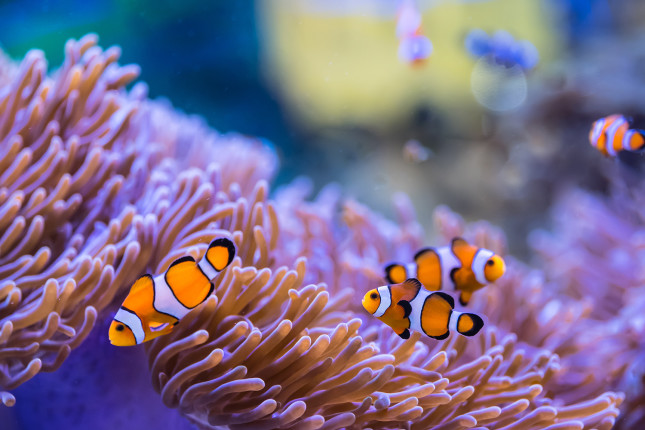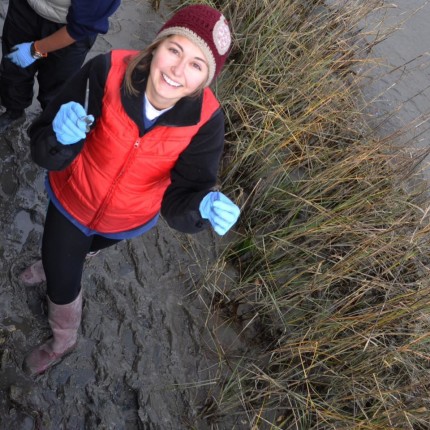-
A Dangerous Taste for Plastic in the Ocean Depths
December 10, 2020 By Zoie Diana If you watched Finding Nemo (who hasn’t?), you may remember Nemo’s home in the beautiful pink sea anemone with its tentacles waving around. These tentacles are able to sting and eat fish, crabs, and sometimes even birds. Lucky for Nemo, clownfish have a mucus coat that protects them from the sea anemone’s poisonous stings. And lucky for the sea anemone, clownfish protect them from being consumed by other fish and provide them nutrients through their food and fecal droppings. Nemo and his fellow clownfish, however, can’t shield these sedentary sea animals from nearly invisible plastic microfibers or plastic preproduction pellets, called nurdles. At Duke University I have been studying one specific species of sea anemone, Aiptasia pallida, which seems to find plastic particularly tasty. My work is part of a larger wave of scientific research around the world looking into how and why sea animals are eating microplastics and how it may impact their health.
If you watched Finding Nemo (who hasn’t?), you may remember Nemo’s home in the beautiful pink sea anemone with its tentacles waving around. These tentacles are able to sting and eat fish, crabs, and sometimes even birds. Lucky for Nemo, clownfish have a mucus coat that protects them from the sea anemone’s poisonous stings. And lucky for the sea anemone, clownfish protect them from being consumed by other fish and provide them nutrients through their food and fecal droppings. Nemo and his fellow clownfish, however, can’t shield these sedentary sea animals from nearly invisible plastic microfibers or plastic preproduction pellets, called nurdles. At Duke University I have been studying one specific species of sea anemone, Aiptasia pallida, which seems to find plastic particularly tasty. My work is part of a larger wave of scientific research around the world looking into how and why sea animals are eating microplastics and how it may impact their health.In a business-as-usual scenario, rates of plastic pollution entering the terrestrial and aquatic environments are expected to vastly increase between now and 2040. Plastic pollution entering the ocean can be transported through currents and gyres (like Nemo hitching a ride on Crush’s back) or sink to the bottom of the ocean, where hotspots of microplastics have been discovered in sediments. This is how plastic nurdles and microfibers get to our hero, the sea anemone.
Sometimes marine animals eat macro plastic waste — cups, straws, plastic wrap — which has known physical effects, like blocking the digestive tract of loggerhead sea turtles and sperm whales. Less understood and potentially more harmful are the chemicals in macro and microplastics that sea animals ingest.

Plastic is Tasty to Marine Animals
Our lab is investigating why marine animals eat plastics. Plastic consumption varies based on the feeding strategy of each animal and the flavors in the plastic debris. Scientists have found that bacteria growing on marine plastic is thought to give off a tasty aroma to seabirds. When plastic enters the ocean, bacteria make it their new home and create floating ecosystems (i.e., the unique microbiome found on plastic, deemed “the Plastisphere”).
In contrast, bacteria is not the condiment of choice for corals. Results from a study in our lab indicate that corals prefer bacteria-free plastic over plastic with a layer of bacteria on it. Sea anemones rely on chemical and mechanical cues to capture prey. Bacteria-free plastic pellets trigger feeding responses in sea anemones (watch it happen in this video). However, previous studies have shown that glass rods and gelatin pellets do not appear as tasty to the animals. Our findings are significant because these plastic pellets lack marine bacteria, suggesting that plastic itself is inherently tasty, even without yummy bacteria on top.
Dangerous Lunch?
Plastics are dynamic; they can leach chemicals or act as a sponge, soaking up pollutants already in the environment. Chemicals that leach from plastic include the additives used to make plastic bendy, colorful, and lightweight. Some 906 chemicals are likely associated with plastic food packaging alone. This includes metal stearates to prevent plastic from breaking down in the sun.
In the marine environment, plastics take up metals and organic compounds, such as polychlorinated biphenyls (PCB), polycyclic aromatic hydrocarbons (PAH), and dichloro-diphenyl-trichloroethane (DDT). As of 2016, almost 800 species of marine animals had been entangled by or consumed marine debris, the majority of which is plastic, including our hero the sea anemone.
Our work shows that anemones that consume plastic end up having increased levels of the environmental toxicant lead in their bodies compared to anemones that did not snack on plastic.
As marine animals eat plastic, it makes its way into and up the food chain. For example, captive seals were found to indirectly consume plastic after eating a meal of wild-caught Atlantic mackerel that had eaten plastics. What does this mean for the sea anemone? In the wild, various fish, crabs, crustaceans, starfish, worms, and sea spiders are thought to eat anemones. In this way, plastic could make its way into the human food chain, especially since an estimated 3 billion people depend on seafood as their primary food source.

Solutions to Plastic Pollution
The threat of plastic in food and even in the air we breathe can seem overwhelming, but encouragingly, governments worldwide are adopting policies to reduce plastic pollution. With researchers at the Nicholas Institute for Environmental Policy Solutions at Duke University and funding support from Pew Charitable Trusts, we completed a study entitled “20 Years of Government Responses to the Global Plastic Pollution Problem,” that characterizes government responses to plastic pollution adopted between January 2000 and mid-2019.
The 291 policies we analyzed in the report are available in a free, searchable database called the Plastics Policy Inventory. Over the study period, governments overwhelmingly adopted policies targeting macroplastics (e.g., plastic bags) — by 2018, nearly half of the global population lived in an area with a bag ban or tax. Low-income and lower-middle-income countries lead the world in the adoption of national-level bans, taxes, or levies on plastic bags. While this is an encouraging trend, governments will need to go beyond bags.
Only nine policies in our sample targeted microplastics (primarily microbeads in cosmetic products), which is concerning because they are released from every type of plastic. Only one policy in the sample, the Convention on Migratory Species, Resolution 12.20 – Management of Marine Debris, targeted microplastics generated from tire abrasion, which are expected to contribute to 93 percent of microplastic pollution by 2040.
A landmark study by Dr. Jenna Jambeck and colleagues found that certain countries have a disproportionate impact on plastic leakage into the ocean. We compared these countries to our sample and found no evidence of national policies for seven of the top 20 countries with the greatest amounts of mismanaged wastes. Our sample had an English language bias so it is possible that these countries may have adopted a national plastics policy.
Despite an increase in the number of policies to reduce plastic pollution adopted annually at all levels of government, scientists are still reporting increasingly large amounts of plastic in the ocean and adverse outcomes for marine animals. Stand-alone policies like bans have not done enough to slow the production and leakage of plastics into the ocean, particularly microplastics.
Encouragingly, we have seen a rise in policies attempting a more comprehensive response to the complex issue of plastic pollution, such as the EU Directive 904/2019, considered an “all of the above” approach targeting multiple plastic types at multiple lifecycle stages. A coalition of nongovernmental organizations and businesses have recently called for a new binding, global treaty to address plastic pollution. More comprehensive and global responses are needed to manage the complex, ubiquitous pollutant that is plastic. Only then can Nemo and his anemone buddy live peacefully.
Zoie Diana is a Ph.D. student in the Rittschof Lab who studies plastic consumption in marine animals and policy responses to plastic pollution with the Nicholas Institute for Environmental Policy Solutions at Duke University.
Sources Animal Wire, Aquatic Toxicology, Baerlocher Additives, Duke University Nicholas School of the Environment, Environmental Pollution, Environmental Science & Technology Letters, Finding Nemo (Clips4You), HealtheBay, Marine Pollution Bulletin, Monterey Bay Aquarium Research Institute, National Geographic, Natural Product Reports, New York Times, Pew Charitable Trusts, PLOS ONE, Reviews in Fisheries Science and Aquaculture, Science Daily, Science Magazine, Science of the Total Environment, Secretariat of the Convention on Biological Diversity, The Biological Bulletin, The World Bank, Time Magazine, UNC-TV Science, Wired, World Wildlife Fund
Lead Image Credit: Clownfish and sea anemone, courtesy of Shutterstock.com.
 A Publication of the Stimson Center.
A Publication of the Stimson Center.









